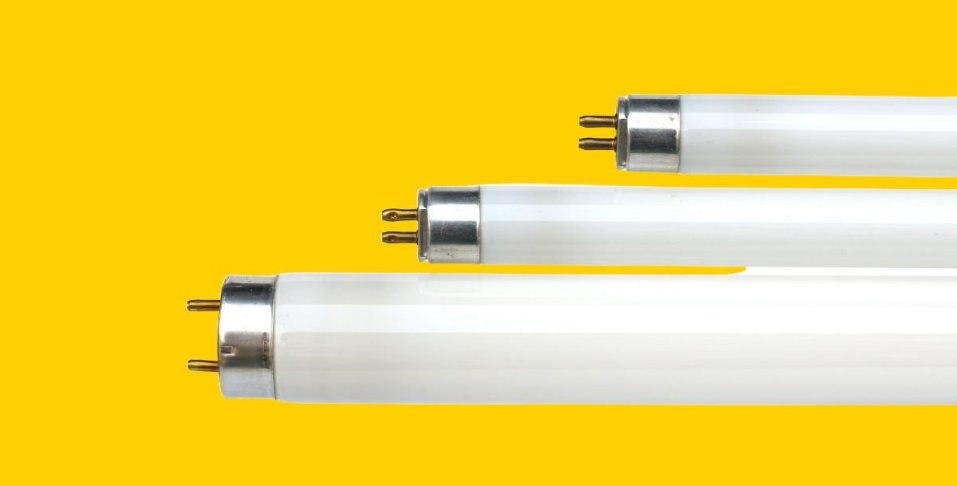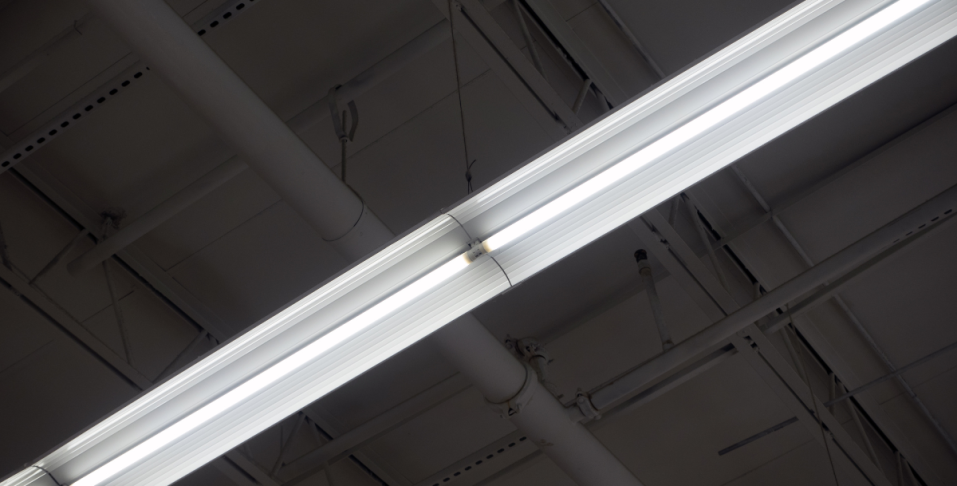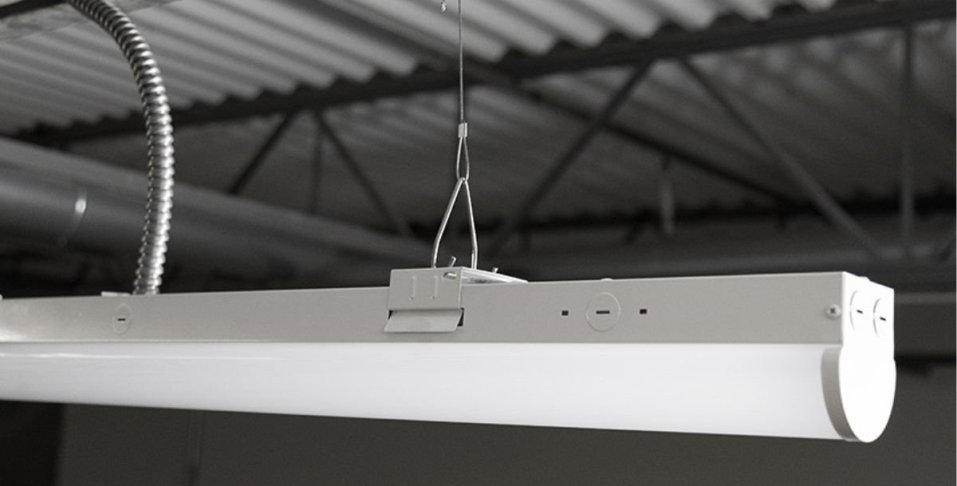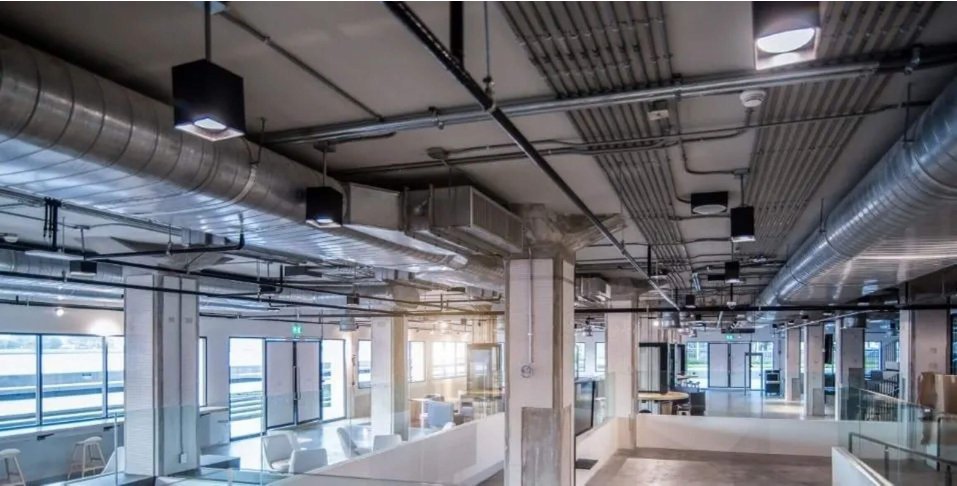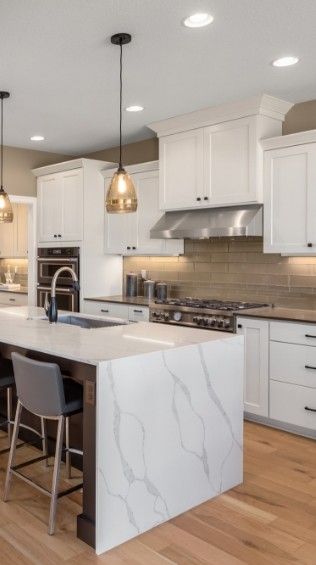Fluorescent Tube Light Replacements
Replacing fluorescent tube lights with LED tube lights offers many benefits. One of the biggest and most well-known benefits of LED tube light replacements is their energy efficiency. LED tube lights use 50-70% less energy than fluorescent tubes. Energy savings can vary depending on the type of bulb.
LED tube lights reduce maintenance costs by eliminating the need for frequent bulb replacements. Our LED tube lights are rated for over 50,000 hours compared to fluorescents which can last up to 15,000 hours.
Other benefits include:
-
Instant-on with no warm-up time
-
Improved light quality- Higher color rendering index (CRI) for color accuracy, range of CCTs for any application
-
No buzzing or flickering, which reduces eye strain
-
Performs well in cold temperatures
LED tube lights are among the most commonly used indoor commercial lighting solutions. They are found in offices, warehouses, workshops, garages, healthcare, schools, retail shops, and more.
LED Tube Light Types
Type A (Plug-and-Play)
Type A tubes, also called direct fit, ballast compatible, or plug-and-play tubes, are designed to work with the fixture's existing ballast and easily replace fluorescent tubes without rewiring.
Their simplicity makes them good for quick retrofits, but their performance depends on the ballast’s compatibility and condition.
How To Install a Type A (Direct Fit) LED Tube Light
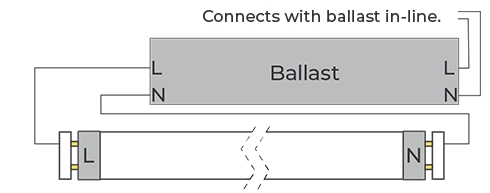

Type B (Ballast-Bypass)
Type B, also called direct wire or ballast-bypass tube lights, requires rewiring and removing the existing fluorescent ballast. Type B tubes can be wired as single-ended or dual-ended. Removing the ballast can improve efficiency and reduce electrical failures resulting from the failure of the ballast.
How To Install a Type B (Direct Wire) LED Tube Light
Single-Ended Type B Wiring


Dual-Ended Type B Wiring


Hybrid (Type A/B)
Hybrids, also known as Type A/B tubes, provide versatile functionality by combining the benefits of both plug-and-play (Type A) and ballast bypass (Type B) designs. They can be installed directly with an existing fluorescent ballast for a quick, hassle-free setup. If the ballast fails or if greater energy efficiency is desired, the tubes can be rewired to bypass the ballast, eliminating compatibility issues and reducing the need for future replacements.
How To Install a Hybrid (Type A/Type B) LED Tube Light


OR


Universal 3-in-1
Type A/B 3-in-1 universal tubes are among the most adaptable LED tube lighting solutions available. These tubes are designed to offer maximum installation flexibility, supporting three key methods of operation. They can be installed using the existing fluorescent ballast for a simple "plug-and-play" setup, minimizing labor and downtime.
Alternatively, the ballast can be bypassed entirely, allowing the tubes to function like standard Type B configurations, whether single-end or dual-end wired. This versatility not only simplifies retrofitting projects but also provides long-term savings by accommodating future ballast failures or upgrades without needing to replace the tubes themselves.
How To Install a Universal 3-in-1 LED Tube Light
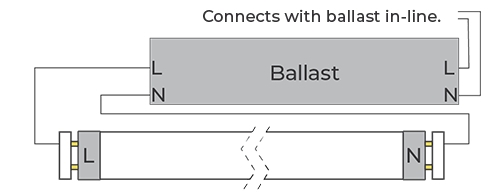
|
OR | 
|
OR | 
|
LED Tube Light Lengths
Our LED tube lights come in a range of lengths. See the chart below for length availability.
|
Type |
Length |
|
T5 |
4 ft |
|
T8 |
2 ft, 4 ft, 8 ft |
|
T8 U-Bend |
6” or 1.6” leg spacing |
|
T9 Circline |
8.75” diameter |
|
T12 |
8 ft (two 4 ft sections) |
What’s The Difference Between T5, T8, and T12 Tube Lights?
The main difference between T5, T8, and T12 LED tube lights is the diameter of the tube. However, there are various differences in their lumen output, energy consumption, installation, and costs.
The below chart compares the differences between T5, T8. and T12 tube lights.
|
Features |
T5 |
T8 |
T12 |
|
Diameter |
⅝ inch (16mm) |
1 inch (25mm) |
1.5 inches (38mm) |
|
Lumen Output (per tube) |
1,400-3,840 lm |
1,440-5460 lm |
4,320-5460 lm |
|
Energy Consumption |
Produces as much or higher light output as T8 and T12 tubes with a smaller form factor. |
Produces as much or higher light output as T8 and T12 tubes with a smaller form factor. |
Least efficient in terms of lumens per watt. They provide lower light output for the same amount of energy consumed. |
|
Common Uses |
High-output fixtures, retail spaces, schools, hospitals, or other commercial environments where high efficiency is necessary. |
General purpose commercial lighting, office buildings, warehouses, garages, industrial spaces, and more. |
Shop lights, workbench lights, factories, and production facilities. |
|
Installation/Ballast Compatibility |
Compatible with electronic ballasts or direct-wire (bypass ballast). |
Compatible with electronic ballasts, direct-wire, or plug-and-play. |
Plug-and-play Type A or ballast bypass Type B operation. |
|
Cost |
Can be two to three times more expensive than T8 bulbs due to higher lumen output. |
The most cost-effective option. |
Least expensive. |
Why Are LED Tube Lights More Energy-Efficient Than Fluorescent Lights?
LED tube lights are significantly more efficient than fluorescent tube lights. This is because LED tube lights require a lower wattage to produce the same brightness, or lumen output, using around 12-18 watts compared to 28-49 watts for fluorescent tube lights. Additionally, LED’s directional lighting focuses light where it’s needed, unlike fluorescents which emit light in all directions, thus wasting energy.
LED tubes also avoid energy lost from ballasts since many types can bypass or eliminate the ballast entirely. They provide instant-on full light output, without warm-up time. LEDs produce minimal heat, converting more power into light. Additionally, their longer lifespan reduces replacements and associated energy costs, further enhancing efficiency.
Fluorescent vs. LED: Energy Savings
|
Bulb Type |
Fluorescent Wattage |
LED Wattage |
Energy Savings |
|
T5 |
21W |
10W |
52% |
|
T5 |
54W |
18W |
67% |
|
T5 |
54W |
24W |
56% |
|
T8 |
17W |
10W |
41% |
|
T8 |
32W |
12W-18W |
42-63% |
|
T8 |
75W |
36W |
52% |
|
T8 |
75W |
42W |
44% |
|
T8 U-Bend |
32W |
13W |
59% |
|
T8 U-Bend |
32W |
15W |
53% |
|
T9 Circline |
30W |
13W |
57% |
|
T12 |
75W |
36W |
52% |
|
T12 |
75W |
42W |
44% |
What’s the Lifespan of LED Tubes Compared to Fluorescent Tubes?
LED tubes last significantly longer than their predecessors, fluorescent tubes. LED tube lights are rated for a lifespan of at least 50,000 hours, while fluorescent tubes typically last between 7,000 and 15,000 hours.
Connection Type: Single-Ended and Dual-Ended
Single-Ended Wiring
Single-end wiring supplies power to only one end of the LED tube, with both the live (hot) and neutral wires connected at the same end of the tube. The opposite end of the tube has no electrical connection and simply holds the tube in place within the fixture. This wiring method is most commonly used in Type B installations, where the ballast is removed.
Installing LED tubes with single-end wiring typically requires bypassing the existing ballast. In many cases, the fixture’s sockets, also known as tombstones, must be replaced with non-shunted versions to ensure proper electrical flow.
Single-end wiring eliminates the need for a ballast, reducing potential failure points in the system. Additionally, it increases energy efficiency by preventing power loss that would otherwise occur through the ballast.
Dual-Ended Wiring
In dual-end wiring configurations, power is supplied to both ends of the LED tube. One end connects to the live (hot) wire, while the other connects to the neutral wire. This setup closely resembles the wiring used for traditional fluorescent tubes, often making the retrofitting process more straightforward.
Some LED tubes designed for dual-end wiring can operate as plug-and-play solutions with existing fluorescent fixtures, provided the ballast is compatible. In Type B installations, where the ballast is bypassed, proper attention must be given to ensure the live and neutral wires are connected to the correct ends of the tube.
Dual-end wiring simplifies installation in fixtures originally designed for fluorescent tubes using this configuration. Less modification is typically required, especially in setups where dual-end wiring is already in place.
Shunted vs. Non-Shunted Tombstones
Shunted tombstones on an LED tube light distribute electricity from a single source to both pins, while non-shunted tombstones deliver power from separate sources to each pin. Understanding how each type functions makes it easy to distinguish between them.
Using the wrong socket type for LED tube lights can result in electrical shorts and potential damage over time. It’s crucial to identify the type of socket in your existing fixture and ensure the LED tube you select is compatible.
-
Shunted tombstones: Used with high-output ballasts; not compatible with single-ended Type B tubes
-
Non-shunted tombstones: Required for single-ended Type B LED tubes
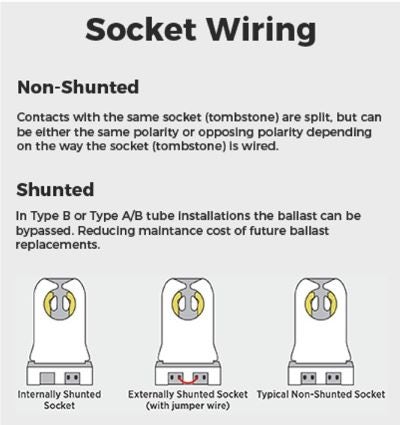

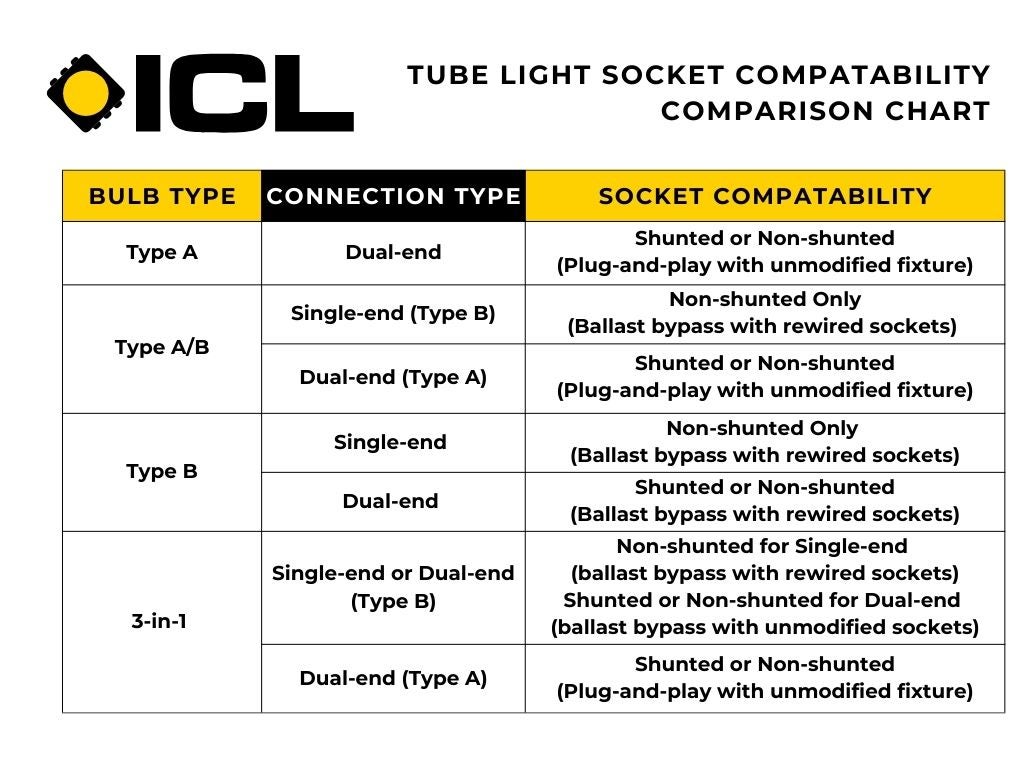

For more information about shunted and non-shunted sockets, read this blog by our affiliate, Super Bright LEDs.
How Do I Know If My LED Tube Is Ballast-Compatible?
There are multiple ways you can check if the LED tube light you are using is ballast compatible or ballast-bypass. A few options are:
-
Check the packaging for "ballast-compatible," "Type A," or "plug-and-play."
-
Review the specifications sheet for supported ballast types.
-
Look for DLC-listed or UL Type A certifications.
-
Confirm your fixture has an electronic ballast (not magnetic).
Certifications and Compliance
Various standards and certifications ensure compliance and safety for commercial lighting solutions, including LED tube lights.
UL Listed (Underwriters Laboratories)
The UL Listed mark indicates that the LED tube light has been tested by Underwriters Laboratories to meet strict safety standards. This certification ensures the product is safe for use in various environments, particularly regarding electrical shock, fire hazards, and mechanical safety. UL certification is widely recognized in North America and provides confidence that the tube light complies with essential safety regulations.
DLC-Listed (DesignLights Consortium)
DLC-listed LED tube lights meet high standards for energy efficiency and performance. The DesignLights Consortium certification is especially important for commercial and industrial applications because it often qualifies the product for utility rebates and incentive programs. DLC certification also ensures that the light output, color quality, and lifespan meet rigorous industry benchmarks, making it a trusted standard for energy-efficient lighting solutions.
ETL Listed (Intertek)
The ETL Listed mark, issued by Intertek, confirms that the LED tube light meets North American safety standards similar to UL certification. ETL conducts independent testing to verify electrical safety, ensuring the product is compliant with national and regional codes. Like UL, the ETL certification gives assurance that the product is safe for installation and use in residential, commercial, and industrial settings.
Conclusion
By considering factors like tube type, ballast compatibility, wattage, color temperature, and certifications such as UL, DLC, and ETL, you can confidently select a reliable, energy-efficient lighting solution. Make the switch to LED tubes and enjoy long-lasting performance, lower energy costs, and improved light quality.
We offer commercial accounts, and our commercial representatives can help you select the proper solution for replacing your fluorescent tubes.


